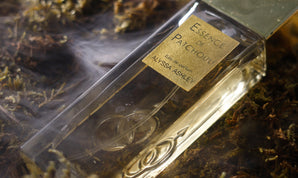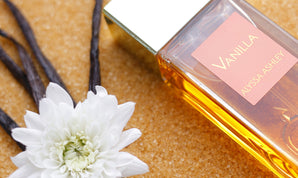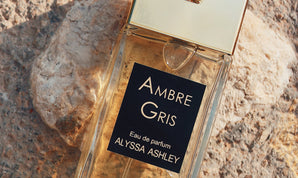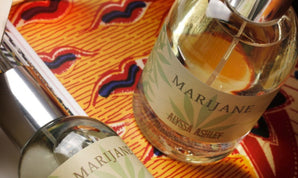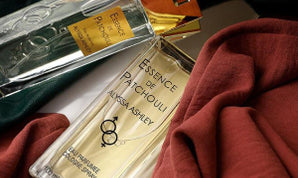Jackson Pollock is universally known as one of the greatest painters of the twentieth century, even the second greatest after Picasso (words of Peggy Guggenheim, famous collector and art expert as well as a patron of Pollock himself).
His fame, linked to the obvious innovation brought to the artistic field, has made his style recognizable by practically everyone, even those less accustomed to art (not to mention those unaccustomed to contemporary art). The "revolutionary" and subversive character of Pollock's painting has inspired my new Red Berry Musk: a perfume that breaks the mould, unleashes energy, just like the artist.
THE DATES
If you ask someone if they've ever heard of Pollock, many will say "no, he doesn't ring a bell", but if you show them one of his paintings from his abstract period (yes, Pollock went through a phase in which he didn't mind painting figures so much...) they'll answer with "oh yes, of course!". This happens because, as is often the case in art, the work has surpassed the artist, or rather in this case, the technique has.
Although, precisely because of their stylistic code, Pollock's abstract paintings may appear very similar to an untrained eye, there is one that has aroused my interest and fascinated me not only for its visual impact but also for what it represents in the artist's life.
It was 1946 when the artist began to undertake in a clearer way an unconscious but profound artistic research, which led him to invent the technique of dripping. It is from this year that we can trace the most intense period of production of works made with this new technique.
The work Red Composition dates back to that date and can be defined as the progenitor of the artist's prolific production, although compared to other later works it provides a certain intrinsic chromatic order and an "ordered chaos".
SYMBOLOGY
As often happens when one crosses the border of figurative art and pushes towards the informal, one loses that subtle link with the symbology that in a certain way still connected abstractionism to an attempt at interpretation. Pollock's abstract informal art therefore goes beyond (as was already the case for other previous artistic currents) the direct interpretative sphere to push you into the unconscious, into the deep, into the infamous gestural expressiveness.
first of all, Pollock's art is spontaneous, not academic (although the artist frequented these environments), an art that lives its own life. This characterized the notes of my Red Berry, far from the olfactory pyramids typical of Musk but always connected to it, born from a liberating, sparkling, spontaneous creative inspiration. A flash, like Pollock's sketches.
Since he was a young boy, the artist had been observing the Native Americans making their famous sand paintings. Shamans in a state of trance used them to read the future, the present and the past of the members of the tribe or of the tribe itself, in a fascinating religious syncretism that the painter immediately grasped. When he himself painted, at a now refined stage of the technique, he would immersively throw himself into the canvas, physically, placing it on the floor and turning around and inside it. The canvas recalled Pollock, made him dance inside it, making him lose - by his own admission - the conception of time and space.
The gestures were liberating, the pure color was thrown from the tubes and then from the cans of enameled paint directly onto the canvas. For Pollock, each sketch ended up where it was supposed to, without anything being accidental, but all studied according to what he felt.
THE COLOR
The work Red Composition, as mentioned, transmits less speed or immediacy but retains the embryonic nature of the artistic explosion and in addition is linked to the color red, not at all accidental.
Red is certainly the color of passion (artistic), of blood (not as a symbol of sacrifice but of vitality understood as lifeblood) but it is above all the color of the red earth of the Native Americans.
Thus a red canvas, like the cloak of a bullfighter, triggers in Pollock a vital flash, a passionate dynamism.
Often Pollock's art has been defined as gloomy or in any case generally not connected to positive feelings, this opinion is linked to the figure of the artist more than to his production. It is now well known that the painter suffered from alcohol addiction and that his death was linked to this, but the interiority shown on the canvas denounces an introspective will to analyze, understand, interpret in the non-scientific sense of the term. Pollock was in fact a connoisseur and admirer of Jungian theories and psychoanalysis in general.
THE GESTURES
Pollock's dynamism is certainly different from other forms of speed and movement of previous artistic movements. In fact, Pollock does not want to represent speed, as, for example, the Futurists did, but speed is the proponent of his representations. The artistic movement of action painting shifts the focus from the sign (whatever it may be) to the movement that that sign has produced, but without the movement becoming the work of art (although Pollock's painting was meant to be a spectacle, it was not a happening). In fact, it is part of the broader movement of abstract expressionism which, however, in the case of the American current, is then unified with it.
The canvases of Rothko, De Kooning and obviously those of Pollock tell of gestures, the fleshiness of painting, the liberation from fixed schemes. Pollock is in fact known for having freed the canvas from the slavery of the easel.
It is this freedom, this spontaneity that I find in the Red Berry Musk. The free spirit of the Musk could only lead this educated rebellion that pushes the mind to take possession of the body, freeing itself from formal constraints. Pollock's rebellion that decides to abandon the easel is the rebellion of the Musk, his artistic unconscious is the ponderousness of the red berries that find an overwhelming final explosion.
My tribute to Pollock is about this: about order within chaos, about the search for self and spontaneity.

